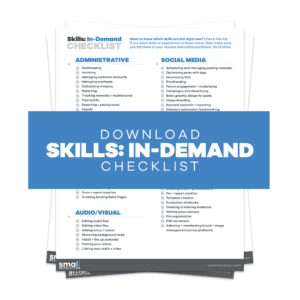The aim of this guide is to help store owners write a useful Customer Marketing Profile that can be used to identify the potential customers of the store and to better understand their needs and demands.
One of the biggest contributing factors to the success of any eCommerce business is knowing and understanding your customers and clients.
In order to do so, it is necessary to include writing a marketing profile or customer profile in your business plan.
Although most business owners – both online and offline – do write a marketing profile, they often do so incorrectly, which then results to their business missing out on the different benefits of identifying and targeting the right market.
Writing a marketing profile generally goes through three different processes:
- Brainstorming about who your market is
- Collecting data about your market
- Organizing those data into meaningful and useful information
These can further be dissected into smaller tasks, which should give you a detailed and step-by-step outline to follow when creating your market profile.
Step 1: Give Your Market A Concrete Image
Market profiling helps you identify who your customers and clients are, and gives insights about the best practices to use to get the best results for your marketing and advertising efforts.
Start your market profiling by giving your customers and clients a concrete image – a “face” you can identify them with – which you can do through demographic profiling.
Demographic profiling refers to identifying the common characteristics of your market such as their age, gender, occupation and income, household size and others.
This is most helpful if you are a Business-to-Community company (B2C) who sells products or offers services that cater to specific groups of end-users (e.g. children’s clothing, gardening and lawn services, etc.)
If your business caters to other businesses (B2B), you’ll have to expand your profiling queries to include different aspects of their business.
When brainstorming, you can use the following questions to get you started:
| For Business-to-Community (B2C) | For Business-to-Business (B2B) |
| How old are our customers and clients? | What sector are they in? |
| Are they primarily male? Female? | How big is their company? |
| Are they working? Are they students? Are they stay-at-home moms? | How much profit do they make? |
| How much do they earn? | Which customers or clients do they cater to? |
| Who are the main decision makers of the company? |
Do remember that there are more questions that you can ask, some of which you can read in Sample Demographic Market Research Questions by Amplitude Research and Business Demographics Survey by Question Pro.
Step 2: Identify Where Your Market Is

Profiling a business may take more effort, but it is all worth it once you see deals closing.
After you have a “face”, the next thing to find out is where they are located through geographic profiling. Geographic profiling is important for ecommerce business for various reasons.
For example, if you are a B2C company, you need to know where your customers are and where to send their orders, which will help you determine your shipping costs and expenses.
Identifying where your customers and clients are located is also important because it tells you where your web presence should be the strongest. If you are a local company, you need to tailor your search engine optimisation (SEO) efforts to boost your searchability in your local community and surrounding areas.
On the other hand, if you are planning to go global, you need to have a strong SEO strategy to help you get ahead of your competitors from all over the world.
Aside from this, geographic profiling also gives you a general insight about the culture of the place and market you are trying to reach.
Step 3: Know How Your Market Think

Once you have a workable image of your customers and clients, it’s time to take a deeper look at who they are through psychographic profiling.
Psychographic profiling goes way beyond their location and physical attributes. It takes a look at the mental make-up of your target market, which in turn can help you plan out a marketing strategy that will tap into their buying behaviour.
Like demographic profiling, there are also variables to consider in psychographic profiling, like their interest or hobbies, their lifestyle, their values and their belief system.
All of these and more play a crucial role in how your market perceives your product and services.
For example, a potential female client of your online clothing store may not buy your latest designs – no matter how trendy and fashionable they are – simply because they think that the style does not fit their lifestyle or even their beliefs.
It is not always easy to come up with the correct psychographic questions for your market, so here is a list of Psychographic Questions from district196.org which you can use in your on psychographic profiling.
Step 4: Find Out How Your Market Behave
Another aspect which you need to profile is your market’s buying behaviour.
There are many things that can influence their buying behaviour such as those mentioned above, but there are more specific questions that you can ask yourselves which can directly pinpoint whether your customers will buy your product or avail of your services.
For one, there is the rate of usage which pertains to how often they will buy your products or require your services.
Second is their loyalty towards your eCommerce business and your competitors.
Third would be their readiness to buy your product or avail of your services.
Some sample questions you can ask yourselves are:
- What would make buyers buy our product or avail of our services?
- Does our marketing strategy encourage them to take action (e.g. buy our products)
- How often will they need our product or services?
- What makes them buy from our competitor?
- Do they pay attention to advertisements?
- Do they spend time and effort in looking for the right product, or do they buy the first to come along?
- How do they look for our products or services? Do they ask friends or search online?
All of these questions will help you to better understand the “why” behind your market’s buying behaviour, which prove to be very useful in planning your marketing strategy.
Here is an Online Shopping Questionnaire you can use, which is fitting for those in the eCommerce business.
Step 5: Learn Why Your Market Come To You

Customers and clients choose to do business with a company because they need something from that company – either a product that they can’t get elsewhere or a service which no one else can give.
Knowing the reason why they chose to do business with you gives you a lot of insights which can help you understand your customers and clients.
It does not only help you choose which product or service to offer them, but also help you reflect on your products and services and how you can innovate and improve them.
Step 6: Collect The Data
Once you have an idea of who your market is and their psychology and buying behaviour, it is now time to collect some real data which you can cross-reference with your template.
There are different ways to do this. You can:
- Review the information from your customer or client data base
- Conduct written surveys or oral interviews
- Study your competitors’ market
- Hold focus groups
- Look at your own observations and that of your employees of the customer or clients
Step 7: Categorise the Information
Once you are done collecting all this information, the next thing to do would be to group them into categories, a process usually referred to as market segmentation.
You can use a table format, an excel spreadsheet, or whatever software program you would like to use to organise these data.
It is also a good idea to give your groups a name instead of calling them group 1, group 2, or market type 1 or market type 2. To do so, try to look at the defining characteristic of each group and use an adjective or word that is most suitable for that particular group.
For example, a fashion online retail store can name their market groups as “Cheap Cathy” for their price conscious markets and “All Out Anna” for their more careless and impulsive customers.
You can create as many groups as you think necessary, although you may want to limit the number to less than ten, or five even.
In the example below, “Homey Homer” is a characterization of small businesses who are local and have simple needs, the opposite of another group of clients referred to as “Earl Everywhere.”
So using the information from the examples given above, here is a sample market profile for a web development and content creation company.
If you are running a similar company, you may find that your clients (law firms, retail stores, article base, etc.) will most likely fall under one of the following.
| Market Name | Homey Homer | Earl Everywhere |
| Demographic Profile | Homey Homer is run by a staff of less than 10. Being such, they have pretty limited capital. They have been in operation for over ten years, and throughout this time they were managed by their company founder and president. Being a small group, they communicate fairly well with each other, and prefer to conduct business personally through meet-ups or telephone conversations. Their revenue stream has been consistent in general – not too small and not too big – just enough to get by and live decently. However, they do want to improve their revenue, and in after much discussion, they decided to try having an online presence through a website. | Earl Everywhere is a relatively new business which has been in operation in less than a year. They have a staff of more or less fifty people, all of whom are very aware of their products and services. Decision making is done by a board of department heads. They are very tech savvy and have tech savvy workers in them, some of which have experience in building websites and blogs in free blogging platforms. |
| Geographic Profile | Their primary operation covers the city where they are based, and sometimes reaches out to customers and clients in nearby areas. | Earl Everywhere is a global business which caters to clients and customers from different countries. |
| Psychographic Profile | Homey Homer is not very tech savvy. They mostly do their marketing offline through flyers and posters and advertisements through the local radio station or newspaper. They are sceptical about having a website since they cater to local clients in their city. Since they are not tech savvy, they mostly rely on trade magazines for information and rarely do their search online and ask their friends and acquaintances for referrals. | Earl Everywhere is very familiar with the internet, and how it can bring benefits to their business. They conduct searches and reads reviews and forums for information. Once they find a company they need, they visit its website and blog, and even befriends them in social media. |
| Behaviour Profile | Homey Homer can be a very loyal customer when they are happy with their contractor. In fact, they have been utilising the services of the same cleaning company throughout their company’s existence. Homey Homer also needs our services on a regular basis, which includes populating their blog and website with content, and conducting minor tweaks and improvements. | Earl Everywhere will continue to hire our services is we prove to be worth it. However, they are always on the lookout for a better and cheaper alternative, and will instantly change contractors once they find one. Until then, Earl Everywhere will continue to hire our services on a regular basis. |
| Needs Profile | What Homey Homer needs is a website that caters to the local context of their business and market – a website that will boost their online presence in the locality they conduct business in. They need a functional website with various ecommerce features, as well as a blog to keep their website populated with fresh content about their business. They will also need to engage with their clients through social media, and have their business listed in Google Place. | Earl Everywhere has a lot of expectations from our company, and will require written outputs from short and simple blog posts to lengthier and more challenging white papers, reviews, case studies about their products or services. They are also very particular with the use of keywords and links and other content optimisation features. |
So what can eCommerce businesses learn from these customer profiles? A lot.
For one, you would see the Homey Homer is the type of client who can be difficult to convince about your services and your company, but can become a great and lasting client once you do.
Thus, your marketing strategy should focus on showing them the benefits of having a website and constant content, as well as the capabilities of your company.
On the other hand, Earl Everywhere is easier to convince about your services because they are all too familiar with its benefits, but you are not easily going to earn their trust. Thus, your marketing should focus on convincing them why they should hire you.
You will also need to build up your social media accounts and SEO because these are where they look for information about your company. Look a little closer and you are bound to find out more.
Here are some more examples of customer profiles which can help provide some guidance and inspiration:
- HubSpot Customer Examples – contains several examples of customer profiles
- Example Buyer Persona – a lengthy and more detailed example of customer profile and buyer persona
Final Checklist
Market Profiling avoids hit-and-miss marketing, which can save your business from a lot of unnecessary marketing expenses.
Writing a marketing profile for your business is a very important step in ensuring the success of your business. To sum it up, here are the things you need to do to create a useful customer profile:
- Give your market a concrete image
- Identify where your market is
- Know how your market think
- Find out how your market behave
- Learn why your market come to you
- Collect the data
- Categorise the information that you have gathered
Once you have done all the steps mentioned above, you will have a better picture of who your market is and how they think and behave.
Using these, you can now create a marketing strategy with these ideal customers in your mind will help you to avoid wasting time and resources on ineffective marketing efforts; thus helping you to reach new customers that your business needs to succeed.


